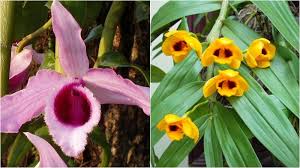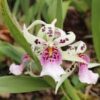### Benefits of Beneficial Insects for Dendrobium Orchids

Dendrobium orchids, known for their stunning blooms and diverse species, thrive in specific environmental conditions. Among the many factors contributing to their health and growth, beneficial insects play a crucial role. These insects not only support the plants’ development but also help create a balanced ecosystem in which orchids can flourish. This article delves into the various beneficial insects associated with Dendrobium orchids, examining their roles, interactions, and overall impact on orchid cultivation.
### 1. Pollinators: The Key to Orchid Reproduction
**1.1. Bees**
Bees are perhaps the most recognized pollinators for a variety of plants, including Dendrobium orchids. With their specialized adaptations, such as long proboscises, bees can reach the nectar deep within the flower. This not only aids in the pollination process but also ensures that the plants produce seeds, which are essential for the continuation of the species.
* **Role in Pollination:** As bees move from flower to flower, they transfer pollen, facilitating fertilization. The mutualistic relationship between bees and orchids is vital, as orchids rely heavily on specific pollinators for reproduction.
* **Promoting Biodiversity:** The presence of bees in an orchid garden indicates a healthy ecosystem. By attracting bees, orchid growers can enhance the genetic diversity of their Dendrobium orchids, leading to more robust and resilient plants.
**1.2. Butterflies and Moths**
Butterflies and moths are also important pollinators for many orchid species. While butterflies are more active during the day, moths tend to be nocturnal, providing pollination services during different times of the day.
* **Attracting Butterflies:** Brightly colored Dendrobium blooms attract butterflies. These insects are drawn to the scent and color of the flowers, contributing to effective pollination.
* **Moths as Night Pollinators:** Many Dendrobium orchids release their fragrances at night, luring moths. These nocturnal pollinators play a significant role in the life cycle of orchids, particularly those that bloom in the evening.
### 2. Natural Pest Control Agents
**2.1. Ladybugs**
Ladybugs, or ladybird beetles, are well-known for their pest control abilities. They primarily feed on aphids, mealybugs, and other soft-bodied insects that can harm Dendrobium orchids.
* **Aphid Control:** Aphids can quickly infest orchids, sucking the sap and weakening the plants. Ladybugs help maintain a balance by preying on these pests, reducing their population and minimizing damage.
* **Encouraging Ladybugs:** Growers can attract ladybugs by planting flowering plants nearby. These beneficial insects are more likely to thrive in environments where they have access to food and shelter.
**2.2. Lacewings**
Lacewing larvae, often called “aphid lions,” are another form of natural pest control. They are voracious predators of aphids and other harmful insects.
* **Lifecycle and Impact:** Lacewings lay their eggs near aphid colonies. Upon hatching, the larvae consume significant numbers of aphids, providing effective control without the need for chemical pesticides.
* **Creating Habitats:** Providing diverse plants and shelter can attract lacewings to the orchid garden, ensuring they contribute to pest management.
### 3. Beneficial Wasps
**3.1. Parasitic Wasps**
Parasitic wasps are tiny insects that play a crucial role in controlling pest populations. They lay their eggs inside or on the bodies of harmful insects, such as aphids and whiteflies, ultimately leading to the pest’s demise.
* **Targeting Specific Pests:** Different species of parasitic wasps target specific pests. For instance, some wasps focus on whiteflies, while others prefer aphids, making them valuable allies for orchid growers.
* **Reducing Pest Infestations:** By incorporating parasitic wasps into the garden, growers can effectively reduce pest numbers and minimize damage to Dendrobium orchids.
**3.2. Pollinating Wasps**
Certain wasps are also involved in the pollination process, particularly for specific orchid species that rely on them for reproduction.
* **Orchid-Wasp Relationships:** Some orchids have evolved to attract specific wasps for pollination. The interaction between these two organisms is a fascinating example of co-evolution.
* **Supporting Biodiversity:** By fostering environments that attract both parasitic and pollinating wasps, orchid growers can enhance the overall health of their gardens.
### 4. Soil-Dwelling Insects
**4.1. Earthworms**
Earthworms are essential for maintaining healthy soil. They aerate the soil, improve drainage, and enhance nutrient availability, all of which are vital for the growth of Dendrobium orchids.
* **Soil Structure Improvement:** The burrowing action of earthworms creates channels that facilitate air and water movement in the soil, promoting healthier root systems.
* **Organic Matter Breakdown:** As earthworms consume organic matter, they break it down into nutrients that are readily available for orchids and other plants.
**4.2. Beetles**
Many beetle species contribute to soil health and pest control. They feed on decaying plant material, helping to recycle nutrients back into the soil.
* **Fertilization through Decomposition:** Beetles play a vital role in decomposing organic matter, which enriches the soil with essential nutrients.
* **Controlling Soil Pests:** Certain beetle species are predatory and can help manage pest populations that threaten orchids, contributing to a balanced ecosystem.
### 5. Nematodes
**5.1. Beneficial Nematodes**
Beneficial nematodes are microscopic roundworms that can help control soil-dwelling pests, such as root weevils and fungus gnats, which can harm Dendrobium orchids.
* **Natural Pest Control:** These nematodes invade and kill harmful insects, offering a natural alternative to chemical pesticides.
* **Soil Health Contribution:** Beneficial nematodes also contribute to soil health by promoting microbial activity and nutrient cycling.
### 6. Integrated Pest Management (IPM)
**6.1. Strategies for Orchid Growers**
Integrating beneficial insects into an orchid cultivation strategy is a cornerstone of Integrated Pest Management (IPM). This approach emphasizes a balanced ecosystem, reducing the reliance on chemical interventions.
* **Diversity in Planting:** Growing a variety of plants alongside Dendrobium orchids can attract beneficial insects, enhancing pollination and pest control.
* **Habitat Creation:** Providing habitats, such as flowering plants, shelter, and water sources, encourages beneficial insect populations to thrive.
**6.2. Monitoring and Assessment**
Regular monitoring of the orchid environment is essential to assess the presence of beneficial insects and identify potential pest issues.
* **Observation Techniques:** Growers should observe insect activity, plant health, and any signs of pest infestation to inform management decisions.
* **Adaptive Management:** An adaptive approach allows growers to modify their strategies based on observed results, promoting a dynamic and responsive cultivation environment.
### 7. Conclusion
The role of beneficial insects in the development of Dendrobium orchids cannot be overstated. From pollinators to pest control agents, these insects contribute significantly to the health and vitality of orchid gardens. By fostering a balanced ecosystem that attracts and supports beneficial insect populations, orchid growers can enhance the growth of their plants while minimizing the need for chemical interventions. Ultimately, understanding and appreciating the interconnectedness of these organisms is essential for successful orchid cultivation.
Incorporating beneficial insects into orchid care not only leads to healthier plants but also promotes biodiversity and sustainability within the garden. By adopting practices that encourage the presence of these allies, growers can enjoy beautiful, thriving Dendrobium orchids for years to come.

